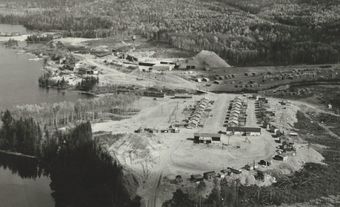
Baie-Comeau
Baie-Comeau, Qué, City, pop 22 554 (2006c), 23 079 (2001c), inc 1937. Baie-Comeau is located on the north shore of the St Lawrence River, at the mouth of the Rivière Manicouagan, 422 km northeast of Québec City. At the start of the 20th century, the area was still a huge hunting and fishing land of the Montagnais-Naskapi, completely isolated and without transportation routes.
Its geographic advantages (deep bay, neighbouring rivers with strong flows, huge forestry resources) led Colonel Robert R. McCormick, publisher of The Chicago Tribune, to build a paper mill and create a town in 1937. It took the name of Napoléon-Alexandre Comeau, a celebrated north shore naturalist. During the 1950s, Baie-Comeau grew rapidly: the Quebec North Shore Paper Co enlarged and renovated its paper factory, a huge aluminum company (Reynolds) came in 1958 and grain silos (Cargill Grain Co) in 1960.
The economic growth of the town and region was stimulated by the 1960 construction of a 448 km highway linking north shore towns and the 1959-79 harnessing of the hydroelectric potential of the Outardes and Manicouagan rivers. The Manic-Outardes complex built by Hydro-Québec supplies Québec City's electricity. The Daniel Johnson Dam (Manic 5), 210 km north of Baie-Comeau, is one of the world's largest. The aluminum smelter has expanded to become the largest in North America. Baie-Comeau is also endowed with a deepwater sea port. Baie-Comeau is the birthplace of Brian Mulroney, former prime minister of Canada.

 Share on Facebook
Share on Facebook Share on X
Share on X Share by Email
Share by Email Share on Google Classroom
Share on Google Classroom

